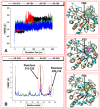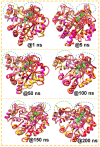Nature-Inspired O-Benzyl Oxime-Based Derivatives as New Dual-Acting Agents Targeting Aldose Reductase and Oxidative Stress
- PMID: 35327641
- PMCID: PMC8946157
- DOI: 10.3390/biom12030448
Nature-Inspired O-Benzyl Oxime-Based Derivatives as New Dual-Acting Agents Targeting Aldose Reductase and Oxidative Stress
Abstract
Aldose reductase (ALR2) is the enzyme in charge of developing cellular toxicity caused by diabetic hyperglycemia, which in turn leads to the generation of reactive oxygen species triggering oxidative stress. Therefore, inhibiting ALR2 while pursuing a concomitant anti-oxidant activity through dual-acting agents is now recognized as the gold standard treatment for preventing or at least delaying the progression of diabetic complications. Herein we describe a novel series of (E)-benzaldehyde O-benzyl oximes 6a-e, 7a-e, 8a-e, and 9-11 as ALR2 inhibitors endowed with anti-oxidant properties. Inspired by the natural products, the synthesized derivatives are characterized by a different polyhydroxy substitution pattern on their benzaldehyde fragment, which proved crucial for both the enzyme inhibitory activity and the anti-oxidant capacity. Derivatives (E)-2,3,4-trihydroxybenzaldehyde O-(3-methoxybenzyl) oxime (7b) and (E)-2,3,4-trihydroxybenzaldehyde O-(4-methoxybenzyl) oxime (8b) turned out to be the most effective dual-acting products, proving to combine the best ALR2 inhibitory properties with significant anti-oxidant efficacy.
Keywords: aldose reductase; aldose reductase inhibitors; anti-oxidants; benzaldehyde O-benzyl oximes; multifunctional compounds.
Conflict of interest statement
The authors declare no conflict of interest.
Figures












Similar articles
-
Pyridothiadiazine derivatives as aldose reductase inhibitors having antioxidant activity.J Enzyme Inhib Med Chem. 2016;31(sup1):126-130. doi: 10.1080/14756366.2016.1178638. Epub 2016 May 6. J Enzyme Inhib Med Chem. 2016. PMID: 27153454
-
Coumarin-thiazole and -oxadiazole derivatives: Synthesis, bioactivity and docking studies for aldose/aldehyde reductase inhibitors.Bioorg Chem. 2016 Oct;68:177-86. doi: 10.1016/j.bioorg.2016.08.005. Epub 2016 Aug 6. Bioorg Chem. 2016. PMID: 27544072
-
Dihydrobenzoxazinone derivatives as aldose reductase inhibitors with antioxidant activity.Bioorg Med Chem. 2020 Oct 15;28(20):115699. doi: 10.1016/j.bmc.2020.115699. Epub 2020 Aug 8. Bioorg Med Chem. 2020. PMID: 33069078
-
Addressing selectivity issues of aldose reductase 2 inhibitors for the management of diabetic complications.Future Med Chem. 2020 Jul;12(14):1327-1358. doi: 10.4155/fmc-2020-0032. Epub 2020 Jun 30. Future Med Chem. 2020. PMID: 32602375 Review.
-
Aldose reductase inhibitors: 2013-present.Expert Opin Ther Pat. 2019 Mar;29(3):199-213. doi: 10.1080/13543776.2019.1582646. Epub 2019 Feb 27. Expert Opin Ther Pat. 2019. PMID: 30760060 Review.
Cited by
-
Cell metabolism pathways involved in the pathophysiological changes of diabetic peripheral neuropathy.Neural Regen Res. 2024 Mar;19(3):598-605. doi: 10.4103/1673-5374.380872. Neural Regen Res. 2024. PMID: 37721290 Free PMC article. Review.
-
Resveratrol Analogs and Prodrugs Differently Affect the Survival of Breast Cancer Cells Impairing Estrogen/Estrogen Receptor α/Neuroglobin Pathway.Int J Mol Sci. 2023 Jan 21;24(3):2148. doi: 10.3390/ijms24032148. Int J Mol Sci. 2023. PMID: 36768470 Free PMC article.
-
Computational Target-Based Screening of Anti-MRSA Natural Products Reveals Potential Multitarget Mechanisms of Action through Peptidoglycan Synthesis Proteins.ACS Omega. 2022 Oct 14;7(42):37896-37906. doi: 10.1021/acsomega.2c05061. eCollection 2022 Oct 25. ACS Omega. 2022. PMID: 36312373 Free PMC article.
-
Resveratrol-like Compounds as SIRT1 Activators.Int J Mol Sci. 2022 Dec 1;23(23):15105. doi: 10.3390/ijms232315105. Int J Mol Sci. 2022. PMID: 36499460 Free PMC article.
-
New Hybrid Compounds Incorporating Natural Products as Multifunctional Agents against Alzheimer's Disease.Pharmaceutics. 2023 Sep 22;15(10):2369. doi: 10.3390/pharmaceutics15102369. Pharmaceutics. 2023. PMID: 37896129 Free PMC article.
References
-
- World Health Organization . WHO Traditional Medicine Strategy: 2014–2023. WHO Press; Geneva, Switzerland: 2013.
MeSH terms
Substances
LinkOut - more resources
Full Text Sources
Research Materials

